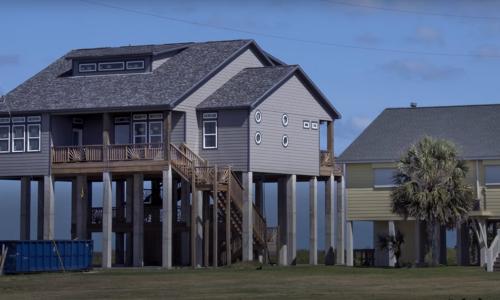“Mother Nature has a way of evening things out”
With the measured voice of a scientist, Galveston County engineer Michael Shannon mused about the seemingly eternal struggle between the irresistible draw human beings have to water and the knowledge that the water, especially in these parts, bites hard.
“People can decide to do what they want, and if you have enough money, you can build what you want if it complies with the regulations,” Shannon said in his office, surrounded by maps that remind one precisely how much water from the Gulf of Mexico and Galveston Bay wraps around Galveston Island, the Bolivar Peninsula, and several local cities and towns.
“I will say, I am surprised at the level of investment and the level of risk people choose to take, but they have the right to do so. It’s human nature to do your own thing and improve your property and live the way you want. I don’t have an opinion whether they should or shouldn’t. But Mother Nature has a way of evening things out.”
Analysis points to a rapid escalation from today’s flooding conditions
This region’s traditional worry is hurricanes. The 1900 hurricane that killed between 6,000 and 12,000 people is still the United States’ deadliest natural disaster. In 2008, Hurricane Ike literally wiped huge swaths of the Bolivar Peninsula off the map. Only 17 people died in the entire state of Texas, but property damage amounting to $50 billion was likely the largest loss in state history, according to the New York Times.
But now, even as the human march back to the shore has resulted in fresh walls of homes and rental units on stilts nearly 20 feet high fronting the Gulf of Mexico, and even as local and state entities have spent tens of millions of federal and state dollars to “renourish” the beaches with hundreds of thousands of cubic yards of sand, the seas are snaking slowly in the opposite direction: over the sand, underneath the pilings, upward onto the land and, when the tide is running particularly high, over the roads and into neighborhoods.
According to a study published this year by Climate Central, a non-partisan organization of scientists and journalists who focus on climate change, nearly half of Galveston’s homes face a yearly risk of flooding by the end of the century if heat-trapping emissions continue to be spewed at the current rate.
On the Bolivar Peninsula, accessible at the western end by ferry from Galveston and connected at the eastern end to the mainland by a lone state highway running just above the water line, nuisance tidal flooding has become more than a nuisance.
“There are a few days when we are actually an island,” said Matt Summers, a firefighter in Crystal Beach on Bolivar Peninsula. “The engineers threw down some concrete barriers alongside the road to keep the water out. The water has knocked them sideways. It’s a false sense of hope.”
UCS analysis points to a rapid escalation from today’s flooding conditions. By 2035, given a moderate scenario for sea level rise, nearly a quarter of the Bolivar Peninsula is expected to flood 26 times or more per year, or every other week, on average.
But not enough has changed to keep up. According to a May article in the Houston Business Journal, one realtor has “rarely seen the Galveston home market so hot in her nearly 40 years in real estate.”
“I’m not an insurance expert, but I just wonder if everything is being done to ensure compliance with insurance requirements in flood hazard zones,” Shannon says.
Last year, the state approved $14 million to repair and raise the highway to an elevation of seven and a half feet. In Galveston, civic and government leaders and environmentalists have spent years debating whether to build a $15 billion storm barrier system featuring dikes and floodgates. This spring, many Texas mayors; port directors; chemical, oil, and gas executives; and recreation and hospitality representatives—as well asTexas Land Commissioner George P. Bush—wrote President Trump to ask the federal government to fund the barrier.
Shannon thinks the general notion of a barrier, or “coastal spine,” as the locals call it, is “a great project,” given the national importance of local industries.
“You pick your poison”
On Bolivar, there is hardly a discouraging word about living in flood zones. Summers said, “I’m sure flooding and hurricanes are in the back of everyone’s head, but the fishing is great and the weather’s warm. You pick your poison. You can live somewhere cold or you can live here and take your chances.”
Local photographer Joe Winston comes from a family that lost a home to Hurricane Ike. They elected not to rebuild. Now living several miles away, he remarked on the new homes on high stilts, “Whether you’re 12 feet off the ground or 18 feet, I don’t know if that’s going to save your home when water flattens it like a pancake.
“You’d think the water was telling us something when we’ve lost hundreds of feet of shoreline over the years to erosion. I heard it once said that a wise man builds his home on a rock while a foolish man builds one on the sand. That is an unpopular thing to discuss in a place people come for vacation. The land may be sinking, the water may be rising, but for most people, they come here to get away from work and the world’s troubles. It’s about living in the here and now. Sea level rise just doesn’t rise to such a critical level that it catches the attention of people.”




